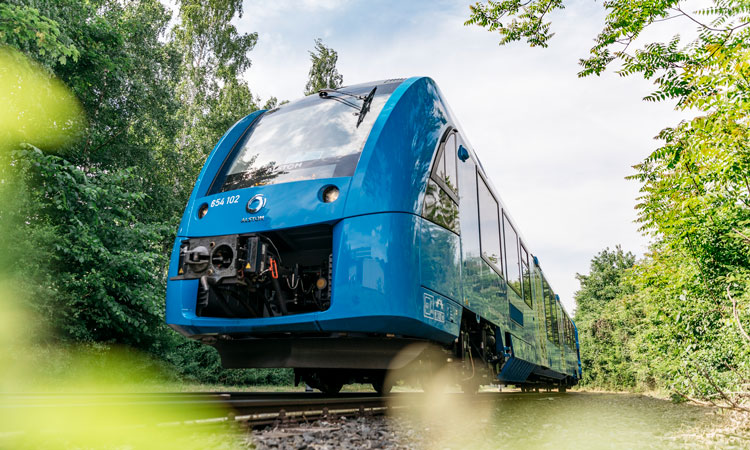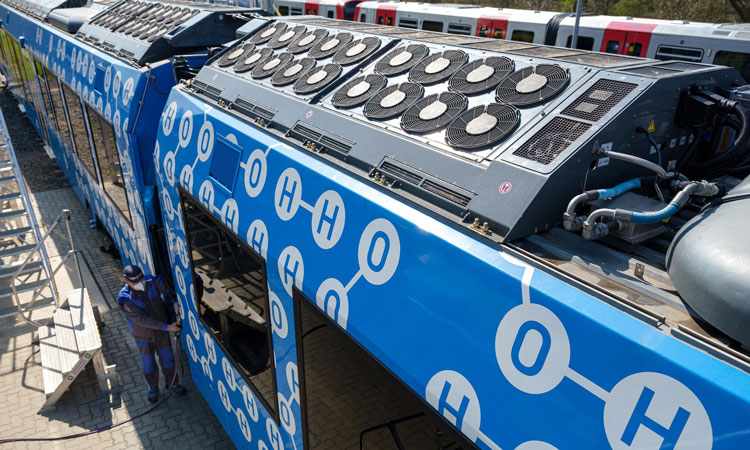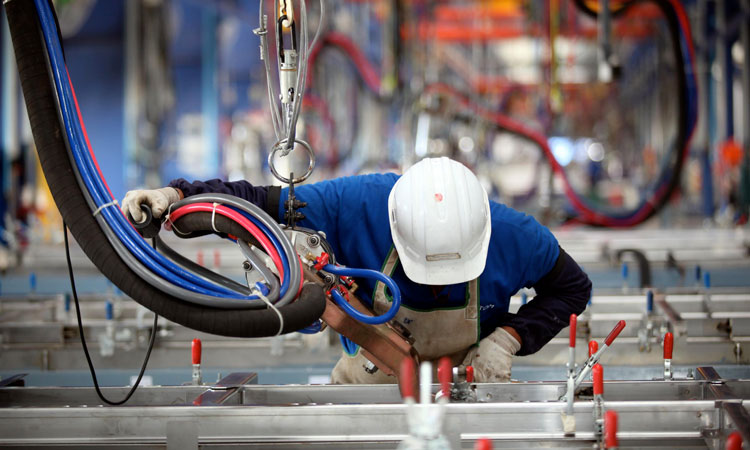Decarbonising rail and delighting the customer with climate innovation
Posted: 14 June 2021 | Anthony Watanabe | No comments yet
Anthony M. Watanabe, Head of Growth – Innovation & Smart Mobility at Alstom, explores several different innovation opportunities for further decarbonising the rail value chain, such as energy optimisation and leveraging digitalisation.


Coradia iLint hydrogen train. Copyright: Alstom Rene Frampe
In addition to scaling traditional rail infrastructure, there are several innovation opportunities for further decarbonising the rail value chain, such as energy optimisation, leveraging digital and more.
Triangulating macro-developments, such as the U.S. re-joining the Paris agreement; the growing influence of the Task Force on Climate-related Disclosure; and the unequivocal pivot of Blackrock towards decarbonising their portfolio, there is reinforced momentum across sectors and geographies for addressing the challenge of climate change. And, for any national, state or local government, transportation is a key part of the mix, typically representing 25 to 30 per cent of CO2 emissions from fuel combustion.
In regions such as Europe, however, rail represents less than two per cent of total transportation emissions. Given rail’s status as the most sustainable mode of motorised transportation, increasing rail’s portion of the mix will directly decrease transportation’s percentage of region emissions and total emissions in general. Rail offers a net environmental benefit, not to mention social benefits around safety and accessibility, and economic benefits related to GDP growth and land value capture.
As previously covered by Global Railway Review, one of the largest contributions to climate solutions is offering alternatives to diesel, specifically through our hydrogen-powered passenger train, Coradia iLint, which emits only water during operation.
In addition to scaling traditional rail infrastructure, there are several innovation opportunities for further decarbonising the rail value chain, such as energy optimisation, leveraging digital and more.
…Alstom’s Climate Innovation is made up of four areas of exploration: renewables; electric vehicle charging; energy storage; and green finance.
Building on Alstom’s already strong portfolio of sustainable solutions and initiatives – such as our science-based targets, our commitment to 100 per cent renewable energy by 2025 and, of course, our hydrogen powered train – our emerging Climate Innovation platform is another example of Alstom’s drive to deliver low-carbon solutions to market.
As a component of our broader Green Mobility strategy, Alstom’s Climate Innovation is made up of four areas of exploration: renewables; electric vehicle charging; energy storage; and green finance.
Renewables
Today, the question around renewables, particularly solar PV, is less about technology readiness and more about which business model best suits a particular application. In the case of mainline, this ranges from panels on a platform roof, where the green energy is consumed at a station level, to power purchase agreements (PPA) on depots, to larger installations which may run parallel to a stretch of track. We are just beginning to see tenders released with solar options or even requirements; a trend that will likely increase due to the high reliability and decreasing costs of the technology.
En route to our goal of 100 per cent renewable energy for our operations, we have successfully commissioned rooftop solar PV at our SriCity plant in India, with several other projects across the world in the pipeline. Leveraging this growing experience to support our customers’ aspirations around renewables is an area of active exploration.


The Coradia iLint emits only water during operation. Copyright: Alstom/Christoph Busse
Electric mobility ecosystem
Complimenting the advent of renewables is the exploding electric mobility ecosystem, starting with EVs and expanding to micro mobility segments, such as e-bikes, e-scooters, e-motorcycles and even e-tuk tuks, which are growing quickly in South and Southeast Asia.
In the mainline segment, not all of these are applicable, of course. However, when thinking of the multimodal nature of mainline passengers, what is the need for charging infrastructure for EVs and e-motorcycles? And how might that need grow over the next five years? How can operators, solution providers and government work together to ensure that this infrastructure is reliable, affordable and sustainable?
The electric mobility ecosystem is even more interesting when considering two further dimensions: business models and energy storage.
The Asian Development Bank predicts that, by 2030, there will be 500 million e-motorcycles in the Asia-Pacific region. As the cheapest form of personalised motorised transportation, two-wheeled motorised vehicles are ubiquitous in the region, with percentage of ownership climbing from 70 per cent in Bangladesh to as much as 95 per cent in Vietnam.
In e-motorcycles, half of the cost of the vehicle is the battery itself. This creates possibilities for new business models like battery leasing, while simultaneously driving down the cost of ownership. As a result, rail operators have a prime opportunity to facilitate this multimodal transformation through their station infrastructure, park & rides, etc.
Furthermore, with all of these e-motorcycle batteries charging at a rail station, what possibilities emerge to store electricity from a rooftop solar array? Or, if this phenomenon reaches critical mass, to leverage these batteries as part of the UPS backup power at a station level? While it is too early to answer this last question, it is nonetheless indicative of the new way of thinking that has been opened up by the convergence of renewables, electric mobility and energy storage.


Work on car body shell at the Alstom Sri City site. Copyright: Alstom Transport/F. Christophoridès
Innovative energy storage
After renewables and EV charging, a third area of exploration relates to energy storage; namely, batteries. Utility scale energy storage costs have dropped by 70 per cent since 2015, and lithium ion battery pack prices have fallen by over 90 per cent in the last decade, according to BloombergNEF.
What does this mean for rail operators looking to increase the reliability, lifespan and environmental profile of wayside batteries? While unit costs may increase, can we drive towards a lower TCO to support customer opex requirements?
And what about deploying second life batteries from EVs into shunting locomotives, or, perhaps, combined with reversible power stations? Such circularity makes economic and environmental sense. The ultimate viability of such an innovation rests on key determinants like performance metrics, reliability of supply and warranties.
Given mounting pressure for decarbonisation and even national net-zero commitments, will we soon see increasing tender requirements for rethinking energy storage?
A recent article in Forbes points to the transformative nature of low-cost batteries in sectors such as transportation, electric utilities and their upstream energy providers and, certainly, rail is no exception.
Green finance
‘Green finance’ is an exciting emerging area for companies such as Alstom, since clean transportation – and, specifically, rail – is a priority investment sector to achieve the transition towards carbon neutrality.
In addition to being independent areas of innovation, renewables, electric mobility and energy storage are constituent parts of a greater whole. When considered as a micro-system, feeding into a macro-system like rail infrastructure, the possibilities to delight both operator and passenger abound.
Still, such innovations require not only a new way of thinking, but also new financial tools. ‘Green finance’ is an exciting emerging area for companies such as Alstom, since clean transportation – and, specifically, rail – is a priority investment sector to achieve the transition towards carbon neutrality.
Alstom, through continuous innovation on its products and production processes, is positioning itself as a sustainable market leader that is fully aligned with the principles of green finance.
Green finance is now ‘taking off’, growing in scale notably thanks to the standardisation of ‘green’ definitions, such as the EU Taxonomy.
As a result, the potential benefits for green project financing are now materialising:
- Export finance agencies aiming more flexible content rules
- Investors and banks showing more risk appetite; possibly reduced financing costs and enhanced liquidity for risky countries.
To cite one example, green bonds have been successfully issued by rail owners and operators in Europe, the Americas and Asia, albeit largely in developed nations.
Khun Surayut Thavikulwat, CFO of the BTS Group – operators of the expanding elevated rapid transit system in Bangkok, Thailand – commented: “Following the successful issuance of our inaugural green bond in April 2019, the first in Thailand marketed to institutional and HNW investors, and our ongoing listing on the Dow Jones Sustainability Index, the BTS Group is eager to explore opportunities for Climate Innovation with key partners like Alstom.”
Conclusion
Like many areas of innovation, Climate Innovation at Alstom cuts across functional boundaries, linking to our efforts in green and smart mobility, our broader sustainability strategy and, most importantly, our focus on delivering value today, while also building a compelling vision of our customers’ needs for tomorrow.


Related topics
Electric/Hybrid Rolling Stock, Hydrogen Trains, Rolling Stock Orders/Developments, Sustainability/Decarbonisation







